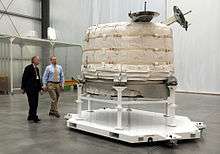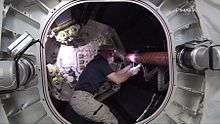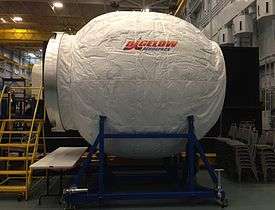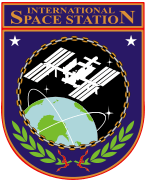Bigelow Expandable Activity Module
|
Full-scale mock-up of BEAM at Johnson Space Center | |
| Station statistics | |
|---|---|
| Launch date: | April 8, 2016, 20:43 UTC[1] |
| Launch vehicle: |
Falcon 9 Full Thrust (SpaceX CRS-8) |
| Berthed: |
April 16, 2016, 09:36 UTC[2] Tranquility aft |
| Unberthed: | Planned: 2018 |
| Mass: | 1,413.0 kg (3,115.1 lb)[3] |
| Length: | 4.01 m (13.2 ft)[4] |
| Diameter: | 3.23 m (10.6 ft)[4] |
| Living volume: | 16.0 m3 (565 cu ft)[4] |
The Bigelow Expandable Activity Module (BEAM) is an experimental expandable space station module developed by Bigelow Aerospace, under contract to NASA, for testing as a temporary module on the International Space Station (ISS) from 2016 to 2018. It arrived at the ISS on April 10, 2016,[5] was berthed to the station on April 16, and was expanded and pressurized on May 28, 2016.
Bigelow plans to build a second BEAM module as an airlock for the Bigelow Commercial Space Station.
History

NASA originally considered the idea of inflatable habitats in the 1960s, and developed the TransHab inflatable module concept in the late 1990s. The TransHab project was cancelled by Congress in 2000,[6][7][8] and Bigelow Aerospace purchased the rights to the patents developed by NASA to pursue private space station designs.[9] In 2006 and 2007, Bigelow launched two demonstration modules to Earth orbit, Genesis I and Genesis II.[10][11]
NASA re-initiated analysis of expandable module technology for a variety of potential missions beginning in early 2010.[12][13] Various options were considered, including procurement from commercial provider Bigelow Aerospace, for providing what in 2010 was proposed to be a torus-shaped storage module for the International Space Station. One application of the toroidal BEAM design was as a centrifuge demo preceding further developments of the NASA Nautilus-X multi-mission exploration concept vehicle.[14] In January 2011, Bigelow projected that the BEAM module could be built and made flight-ready 24 months after a build contract was secured.[15]
On December 20, 2012, NASA awarded Bigelow Aerospace a US$17.8 million contract to construct the Bigelow Expandable Activity Module under NASA's Advanced Exploration Systems (AES) Program.[16][17] Sierra Nevada Corporation built the $2 million Common Berthing Mechanism under a 16-month firm-fixed-price contract awarded in May 2013.[18] NASA plans made public in mid-2013 called for a 2015 delivery of the module to the ISS.[18] During a press event on March 12, 2015, at the Bigelow Aerospace facility in North Las Vegas, the completed ISS flight unit, compacted and with two Canadarm2 grapple fixtures attached, was displayed for the media.[19]
Deployment and status

In early 2015, BEAM was scheduled for deployment on the next available ISS transport vehicle, SpaceX CRS-8, which was scheduled for launch in September 2015. Due to a rocket failure during the SpaceX CRS-7 launch in June 2015, the delivery of BEAM was delayed.[20][21] The successful launch of SpaceX CRS-8 took place on April 8, 2016,[22] and the Dragon cargo vehicle was berthed to the nadir port of Harmony node on April 10.[23] On April 16, British astronaut Tim Peake extracted BEAM from Dragon's trunk using Canadarm2, and installed it on the aft port of Tranquility node.[24]
The first attempt at module inflation took place on May 26, 2016, and was suspended after higher-than-expected air pressure inside BEAM was detected with minimal expansion of the module.[25] The attempt was called off after two hours.[26] The failure to expand and unfold is thought to have been the result of the unanticipated 10-month delay in module inflation, which may have caused the fabric layers to stick together.[25] The module was expanded on May 28 over the course of seven hours, with air being injected 25 times for a total of 2 minutes 27 seconds.[27] Its length was extended 170 cm (67 in) from its stowed configuration, 2.5 cm (1 in) less than expected.[28] After expansion was complete, air tanks aboard BEAM were opened to equalize air pressure in the module with that of the ISS.[29] The module will be monitored for two years.[28][29]

On June 6, 2016, astronaut Jeff Williams and cosmonaut Oleg Skripochka opened the hatch to BEAM and entered to collect an air sample, download expansion data from sensors, and install monitoring equipment. The hatch to BEAM was re-sealed on June 8 after three days of tests.[30][31] A second round of tests took place on September 29 of that same year when astronaut Kathleen Rubins entered the module to install temporary monitoring equipment.[32]
Objectives
The BEAM is an experimental program in an effort to test and validate expandable habitat technology.[33] If BEAM performs favorably, it could lead to development of expandable habitation structures for future crews traveling in deep space.[34] The two-year demonstration period will: [33][35]
- Demonstrate launch and deployment of a commercial inflatable module. Implement folding and packaging techniques for inflatable shell. Implement a venting system for inflatable shell during ascent to ISS.
- Determine radiation protection capability of inflatable structures.
- Demonstrate design performance of commercial inflatable structure like thermal, structural, mechanical durability, long term leak performance, etc.
- Demonstrate safe deployment and operation of an inflatable structure in a flight mission.
At the end of BEAM's mission, it will be removed from the ISS and burn up during reentry.[36]
Characteristics
.jpg)
BEAM is composed of two metal bulkheads, an aluminum structure, and multiple layers of soft fabric with spacing between layers, protecting an internal restraint and bladder system;[37] it has neither windows nor internal power.[38] The module was expanded about a month after being attached to the space station. It was inflated from its packed dimensions of 2.16 m (7.1 ft) long and 2.36 m (7.7 ft) in diameter to its pressurized dimensions of 4.01 m (13.2 ft) long and 3.23 m (10.6 ft) in diameter.[4] The module has a mass of 1,413.0 kg (3,115.1 lb),[3] and its interior pressure is 14.7 pounds per square inch (1 atm), the same as inside of the ISS.[39]
BEAM's internal dimensions provide 16 m3 (565 cu ft) of volume where a crew member will enter the module three to four times per year to collect sensor data, perform microbial surface sampling, conduct periodic change-out of the radiation area monitors, and inspect the general condition of the module.[40][37] The hatch to the module will otherwise remain closed.[41] Its interior is described as being "a large closet with padded white walls", with various equipment and sensors attached to two central supports.[42]
Radiation shielding
The flexible Kevlar-like materials of construction are proprietary.[43][44] The multiple layers of flexible fabric and closed-cell vinyl polymer foam[45] in the BEAM structural shell are expected to provide impact protection (see Whipple shield) as well as radiation protection, but model calculations need to be validated by actual measurements.[37]
In a 2002 NASA study, it was suggested that materials that have high hydrogen contents, such as polyethylene, can reduce primary and secondary radiation to a greater extent than metals, such as aluminum.[46] Vinyl polymer may also be used in laboratories and other applications for radiation shield garments.[47]
BCSS airlock
As of 2013, Bigelow mentioned a concept to build a second BEAM module for use as an airlock on its planned Bigelow Commercial Space Station. The module's inflatable nature would provide room for up to three crew or tourists to spacewalk simultaneously, compared with a maximum of two that can operate outside the ISS.[48]
Gallery
 Interior of BEAM mock-up
Interior of BEAM mock-up BEAM development unit undergoing burst test
BEAM development unit undergoing burst test.jpg) BEAM being loaded into Dragon's trunk in February 2016
BEAM being loaded into Dragon's trunk in February 2016
See also
- B330, an inflatable space habitat
References
- ↑ Gebhardt, Chris (April 9, 2016). "ISS welcomes CRS-8 Dragon after flawless launch". NASA Spaceflight. Retrieved April 26, 2016.
- ↑ Space_Station (April 16, 2016). "#BEAM is attached to the station at 5:36am ET, a huge step for expandable habitats in space and our #JourneyToMars." (Tweet). Retrieved April 27, 2016 – via Twitter.
- 1 2 "SpaceX CRS-8 Mission Overview" (PDF). NASA. Retrieved April 26, 2016.
- 1 2 3 4 Grush, Loren (April 5, 2016). "How expandable astronaut habitats could pave the way for private space hotels". The Verge. Retrieved April 26, 2016.
- ↑ Pearlman, Robert (April 10, 2016). "SpaceX Dragon Arrives at Space Station, Delivers Inflatable Room Prototype". Space.com. Retrieved April 11, 2016.
- ↑ "National Aeronautics and Space Administration Authorization Act of 2000". Library of Congress. 106th Congress. January 24, 2000. Retrieved May 26, 2007.
- ↑ Sensenbrenner, F. James (September 12, 2000). "National Aeronautics and Space Administration Authorization Act of 2000, Conference Report". Library of Congress. 106th Congress. Retrieved June 10, 2007.
- ↑ Abbey, George W. S. (February 27, 2001). "Letter from NASA JSC Center Director: Actions Required to Address ISS Budget Challenges". NASA via SpaceRef.com. Retrieved June 10, 2007.
- ↑ Seedhouse, Erik (2014). Bigelow Aerospace: Colonizing Space One Module at a Time. Springer-Praxis. p. 8. doi:10.1007/978-3-319-05197-0. ISBN 978-3-319-05197-0.
- ↑ David, Leonard (July 12, 2006). "Exclusive: Bigelow Orbital Module Launched into Space". Space.com. Retrieved April 26, 2016.
- ↑ Ledford, Heidi (July 5, 2007). "Second space 'hotel' model launched". Nature. doi:10.1038/news070702-13. Retrieved April 26, 2016.
- ↑ Marks, Paul (March 3, 2010). "NASA turned on by blow-up space stations". New Scientist. Archived from the original on January 18, 2013. Retrieved March 3, 2010.
- ↑ Sang, Tony; Spexarth, Gary (May 26, 2010). "A New Space Enterprise of Exploration: Inflatable Module Mission" (PDF). NASA. Archived (PDF) from the original on January 18, 2013.
- ↑ Lindsey, Clark S. (January 28, 2011). "NASA NAUTILUS-X: multi-mission exploration vehicle includes centrifuge, which would be tested at ISS". HobbySpace.com. Archived from the original on April 19, 2011.
- ↑ David, Leonard (January 26, 2011). "International Space Station Could Get Private Inflatable Room". Space.com. Archived from the original on January 18, 2013. Retrieved January 31, 2011.
- ↑ "NASA Contract to Bigelow Aerospace". NASA via SpaceRef.com. January 11, 2013. Archived from the original on January 18, 2013.
- ↑ "NASA to Test Bigelow Expandable Module on Space Station". NASA. January 16, 2013. Archived from the original on January 19, 2013.
- 1 2 Leone, Dan (June 12, 2013). "Sierra Nevada Corp. To Build ISS Berthing Hardware for Bigelow Module". Space News.
- ↑ Webb, Carlyle (March 12, 2015). "New Expandable Addition on Space Station to Gather Critical Data for Future Space Habitat Systems". NASA.
- ↑ Bergin, Chris (September 7, 2015). "SpaceX conducts additional Falcon 9 improvements ahead of busy schedule". NASA Spaceflight. Retrieved April 26, 2016.
- ↑ "Launch Log". Spaceflight Now. April 8, 2016. Archived from the original on April 22, 2016.
- ↑ Graham, William (April 8, 2016). "SpaceX return Dragon to space as Falcon 9 nails ASDS landing". NASA Spaceflight. Retrieved April 26, 2016.
- ↑ Kremer, Ken (April 11, 2016). "SpaceX Dragon Carrying New Inflatable Room Captured and Mated to Space Station". Universe Today. Retrieved April 26, 2016.
- ↑ Clark, Stephen (April 16, 2016). "Expandable room installed on space station". Spaceflight Now. Retrieved April 26, 2016.
- 1 2 Wall, Mike (May 27, 2016). "NASA Will Try to Pump Up Inflatable Space Station Room Again Saturday". Space.com. Retrieved May 31, 2016.
- ↑ Duhaime-Ross, Arielle (May 27, 2016). "NASA's first expandable habitat failed to inflate on the ISS because of friction". The Verge. Retrieved June 2, 2016.
- ↑ Garcia, Mark (May 28, 2016). "BEAM Expanded To Full Size". NASA. Retrieved June 3, 2016.
- 1 2 Smith, Marcia S. (May 28, 2016). "BEAM Successfully Expanded". SpacePolicyOnline.com. Retrieved June 3, 2016.
- 1 2 Foust, Jeff (May 28, 2016). "BEAM module fully expanded on space station". SpaceNews. Retrieved June 3, 2016.
- ↑ Huot, Daniel G. (June 6, 2016). "BEAM Open for the First Time". NASA. Retrieved June 19, 2016.
- ↑ Garcia, Mark (June 8, 2016). "BEAM Closed as Crew Packs Spaceships for Departure". NASA. Retrieved October 1, 2016.
- ↑ Garcia, Mark (September 29, 2016). "BEAM Open Today for Tests". NASA. Retrieved October 1, 2016.
- 1 2 "Bigelow Expandable Activity Module (BEAM)". Bigelow Aerospace. NASA. March 16, 2016. Retrieved April 3, 2016.
- ↑ "Bigelow Expandable Activity Module". NASA. Retrieved March 28, 2016.
- ↑ "BEAM: The Experimental Platform". Bigelow Aerospace. Retrieved April 26, 2016.
- ↑ Marks, Paul (January 16, 2013). "NASA buys blow-up habitat for space station astronauts". New Scientist. Archived from the original on January 18, 2013.
- 1 2 3 Mahoney, Erin (July 17, 2015). "BEAM Facts, Figures, FAQs". NASA. Retrieved April 3, 2016.
- ↑ Lieberman, Bruce (September 2015). "The Future of Construction in Space". Air & Space/Smithsonian. Retrieved April 27, 2016.
- ↑ Seppala, Timothy J. (March 25, 2016). "NASA to use the ISS as a testbed for inflatable living modules". Engadget. Retrieved April 26, 2016.
- ↑ Robison, Jennifer (January 16, 2013). "North Las Vegas-based Bigelow Aerospace lands $17.8 million NASA contract". Las Vegas Review-Journal. Archived from the original on January 19, 2013.
- ↑ Vastag, Brian (January 16, 2013). "International space station to receive inflatable module". The Washington Post. Archived from the original on January 19, 2013.
- ↑ Dreier, Hannah (January 17, 2013). "Space station to get $18 million balloon-like room". Associated Press. Archived from the original on January 19, 2013.
- ↑ US patent US 7204460 B2, Bigelow, Robert T., "Orbital debris shield", published 2007-04-17, issued 2007-04-17
- ↑ Lyle, Karen H.; Vassilakos, Gregory J. (November 2015). "Modeling of Local BEAM Structure for Evaluation of MMOD Impacts to Support Development of a Health Monitoring System" (PDF). NASA Langley Research Center. NASA/TM-2015-218985.
- ↑ Seedhouse, Erik (2014). Bigelow Aerospace: Colonizing Space One Module at a Time. Springer-Praxis. p. 26. doi:10.1007/978-3-319-05197-0. ISBN 978-3-319-05197-0.
A middle layer was a closed-cell vinyl foam for radiation protection and thermal insulation.
- ↑ "Understanding Space Radiation" (PDF). NASA Facts. NASA Johnson Space Center. October 2002. FS-2002-10-080-JSC. Retrieved April 3, 2016.
- ↑ Murphy, Marina (November 15, 2002). "Lightweight radiation-proof fabric unveiled". New Scientist. Retrieved April 26, 2016.
- ↑ Franzen, Carl (January 17, 2013). "Inflatable Spacecraft's Other Goal: Space Walks For Tourists". Talking Points Memo. Archived from the original on January 19, 2013.
External links
| Wikimedia Commons has media related to Bigelow Expandable Activity Module. |
- BEAM at BigelowAerospace.com
- BEAM at NASA.gov
- BEAM installation animation at YouTube
- BEAM expansion time lapse at YouTube

